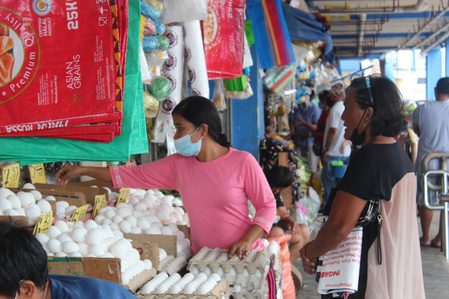SUMMARY
This is AI generated summarization, which may have errors. For context, always refer to the full article.

We are republishing this from marengwinniemonsod.ph with permission from the author.
Think on it, Reader. Twice within a year, sugar scandals have hit the Department of Agriculture (DA) and the Sugar Regulatory Administration (SRA).
Scandal #1
The first scandal, if you will recall, was President Ferdinand Marcos Jr., as agriculture secretary, and also chair of the SRA, repudiated an SRA order (Sugar Order No. 4 or SO-4) for the importation of 300,000 tons of sugar. The SO-4 had been signed by the SRA administrator, the planters’ and millers’ representatives in the SRA, and senior DA undersecretary Leocadio Sebastian who signed for the president as agriculture secretary/SRA chair.
These four signatories claimed that they had talked to and received the President’s/DA Sec.’s/SRA Chair’s blessing before signing the order. The President/DA Sec/SRA Chair claimed that he had not given his blessing. He-said-she-said. Anyway, the SRA Administrator, the DA undersecretary, and the other members tendered their resignations, which were accepted. Investigations were started. No sugar was imported.
Why is this important to we, the Filipino people?
Because as all this was taking place, we were paying 80% more for sugar than what we paid the year before: The price of refined sugar in groceries/supermarkets went from P54.46 in August 18, 2021, to P98.38 August 18, 2022 (SRA Price Monitoring Reports).
Why? Because there was a shortage of sugar. Production had decreased from one year to the next, which was exacerbated by the attempts of traders to profit from the situation. How do we know the traders were profiting? The unusual gap between the millgate price of sugar and its retail price, which means traders’ margins were increasing.
The law of demand and supply not being subject to amendment, the increase in price followed. The objective of the SRA SO-4 was to increase supply/decrease price. That original-but-repudiated-decision was evidence-based.
Long Story Short: The inability to import was one of the major reasons that the year-on-year inflation rate for the item Sugar, Confectionery and Deserts for February 2023, as reported by the PSA (Consumer Price Index for subgroups), was a whopping 37%. That is the highest inflation rate for all items in the CPI. Not only that. Prices for this subgroup also rose between January to February this year. We, the people, suffered.
Post Script: Last December, the Office of the President cleared all members of the SRA, including Undersecretary Sebastian, of bad faith in the sugar importation order. In fact, just last week, Sebastian returned to the DA as undersecretary for Rice Industry Development. If it wasn’t their fault – and I am certain that theirs was the correct move just as I am certain that any agriculture secretary worth his salt would have known that this was the correct move, or for that matter, any intelligent consumer of economic information – whose fault was it? The blame (impliedly) was placed on the now-resigned Executive Secretary Victor Rodriguez.
Scandal #2
This also involves the SRA and the DA, through senior undersecretary Domingo Panganiban, in the same role as Leocadio Sebastian. It also involves a sugar importation order, Sugar Order No. 6 or SO-6, which mandates the importation of 440,000 metric tons (mt) of sugar, also to cover the country’s supply shortage. Without demur from the President/DA Sec/SRA Chair. But there are other differences. This scandal has dangerous repercussions.
1. SO-6 was released on February 15, to take effect on February 19. The first 100,000 tons is scheduled to arrive ASAP, the second 100,000 was to arrive before April 1, and the remaining 240,000 tons, the buffer stock, was to arrive on April 1 or later. But a shipment of 5,000 tons arrived in Batangas on February 9, way before the effectivity of SO-6. Having no SRA approved documents, this shipment should be considered smuggled. Instead, Panganiban, in a memo dated February 27, ordered the SRA administrator to effectively legitimize the shipment by issuing a Release Order. The latter obeyed.
2. Actually, that February 27 memo asked the SRA administrator to issue Clearances for the Release of Imported Sugar (SRA Clearance) to three international sugar traders, in direct contravention of SO-6, in spite of the fact that the latter already gives the DA the discretionary authority to approve import allocations (but the SRA must recommend), and to waive or reduce the P850 per-50-kilogram bag performance bond which the SRA requires of the trader before issuing an SRA clearance.
Why “in direct contravention” of SO-6? Because under the latter, all accredited international sugar traders in good standing are eligible to apply to import. They must submit their applications by February 25 and the volumes allowed per applicant, i.e. their share of the 440,000 metric imports, would be awarded on March 1. These volumes per eligible importer were, historically, prorated according to their excise tax payments.
Panganiban, self-admittedly, ignored all of that. He:
(i) arbitrarily chose only three international traders and,
(ii) just as arbitrarily, chose the volumes each would import:
- All Asian Countertrade Inc., 240,000 mt;
- Edison Lee Marketing Corp., 100,100 mt;
- S&D Sucden Philippines Inc., 100,000 mt.
And there is no move so far to prosecute him.
(iii) He asked these companies to proceed with the importation of sugar provided that “they agree to reduce the prices of sugar, sell the commodity at a price that is commercially acceptable in the market, and that they will shoulder the cost…”
(iii) He asked these companies to proceed with the importation of sugar provided that “they agree to reduce the prices of sugar, sell the commodity at a price that is commercially acceptable in the market, and that they will shoulder the cost…”.
What does that mean?
We should ask these questions:
Is there a contract – in black and white? For example, what precisely is a price “commercially acceptable” in the market? The average current price (March 3) in Metro Manila is P105.31 in groceries and P97.61 in public markets. The price before the sugar crisis began was P54.46 (see above).
What would be “commercially acceptable in the market”?
For your information, Reader, current Thai (where we import sugar from) price is $0.63 x P55.04 = P34.67/kg. and and the average price for all countries is $1.39 x P55.04 = P76.51. Shouldn’t a “commercially acceptable…” price fall somewhere in between those two prices? Why did Panganiban leave it open?
Just imagine, Reader – one person exercising sole discretion, bereft of guidelines, rules or transparency and, therefore, probably in violation of the Anti-Graft and Corrupt Practices Act (Republic Act 3019).
Think, Reader. How grateful these three favored international traders must be that they were showered with these favors. Now ask yourself: how will this gratitude be expressed?
But think deeper: Why is the DA being given these new powers? Does that mean that the president will stay as Secretary of DA?
And think deepest: Are the heads of these three companies among the first cronies of PBBM [President Bongbong Marcos] who will take over all sugar trading, as what happened during the dictatorship?
Now go the last mile: Doesn’t it scare you that while Marcos Sr. needed martial law to give goodies to his cronies, the present administration seems to just ignore the law, and get away with it?
Your takeaway:
1. We are paying 80% more for sugar today than in 2021.
2. The price of sugar in the Philippines is higher than Thailand’s and the all-countries average:
- Philippines: P97-105 per kilo (March 3)
- Thailand: P37.54/k
- All countries average: P76.51/k
3. We import rice from Thailand. (See their prices above)
4. Last year’s failure to import contributed to “sugar, confectionery, deserts” prices rising by 37%. We paid for that.
5. Last February, DA allowed sugar imports but is breaking all of its rules and handpicking who will import. Cronyism anew? We too, will bear the costs of that. – Rappler.com
Solita “Winnie” Monsod was the first National Economic and Development Authority secretary appointed after the fall of the Marcos dictatorship in 1986. She is a professor emerita at the UP School of Economics where she taught starting 1983. She finished her degree in economics in UP and obtained her masters in economics at the University of Pennsylvania. She is a board director of Rappler Inc.
Add a comment
How does this make you feel?

![[Vantage Point] The curious case of premature sugar importation](https://www.rappler.com/tachyon/2023/02/TL-curious-case-premature-sugar-importation-February-25-2023.jpg?fit=449%2C449)
![[In This Economy] Marcos’ POGO ban is popular, but will it work?](https://www.rappler.com/tachyon/2024/07/thought-leaders-marcos-pogo-ban.jpg?resize=257%2C257&crop=255px%2C0px%2C720px%2C720px)
![[Rappler Investigates] POGOs no-go as Typhoon Carina exits](https://www.rappler.com/tachyon/2024/07/newsletter-graphics-carina-pogo.jpg?resize=257%2C257&crop=424px%2C0px%2C1080px%2C1080px)








There are no comments yet. Add your comment to start the conversation.